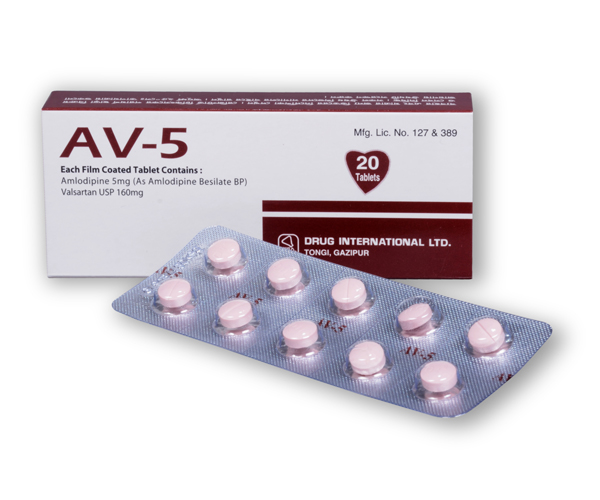
Type:Tablet
Generic Name:Amlodipine + Valsartan
Manufacturer:Drug International Ltd.
Price:৳12.00
Hypertension Initiate with 5 mg/160 mg PO qDay OR Substitute for individually titrated components May increase dose after at least 2 weeks, not to exceed 10 mg/day amlodipine and 320 mg/day valsartan May be adminsitered concomitantly with other antihypertensive agents Hepatic impairment Not recommended for initial therapy; amlodipine 2.5 mg is not an available strength with available dosage forms for this drug combination Amlodipine: Exposure is increased with hepatic insufficiency, consider decreasing dose Valsartan: Exposure increased with mild-to-moderate hepatic insufficiency does not require dosage adjustment; unknown for severe hepatic impairment Elderly: Since both components of the combination are equally well tolerated when used at similar doses in elderly or younger patients, normal dosage regimens are recommended.
Amlodipine : Plasma concentrations may be elevated w/ CYP3A4 inhibitors (e.g. azole antifungals, ritonavir). Concomitant therapy w/ simvastatin may increase risk of myopathy including rhabdomyolysis. May increase ciclosporin plasma levels and conivaptan. Valsartan : May antagonise hypotensive effects and increase the risk of renal impairment w/ NSAIDs. Increased risk of hyperkalaemia w/ K-sparing diuretics, K supplements or K-containing salt substitutes. Potentially Fatal: Increased risk of hypotension, hyperkalemia and changes in renal function (including acute renal failure) when used w/ aliskiren in patients w/ diabetes and renal impairment (GFR <60 mL/min).
Impaired liver or renal function, CHF, sick-sinus syndrome, severe ventricular dysfunction, hypertrophic cardiomyopathy, severe aortic stenosis. Caution when used in patients with idiopathic hypertrophic subaortic stenosis. Elderly, children. During the second and third trimesters of pregnancy, these drugs have been associated with fetal injury that includes hypotension, neonatal skull hypoplasia, anuria, reversible or irreversible renal failure, and death. Discontinue as soon as possible when pregnancy is detected; affects renin-angiotensin system causing oligohydramnios, which may result in fetal injury and/or death Lactation: discontinue drug or do not nurse
Pregnancy Category: C (1st trimester); D (2nd & 3rd trimesters).
Amlodipine relaxes peripheral and coronary vascular smooth muscle. It produces coronary vasodilation by inhibiting the entry of Ca ions into the slow channels or select voltage-sensitive channels of the vascular smooth muscle and myocardium during depolarisation. It also increases myocardial oxygen delivery in patients w/ vasospastic angina. Valsartan, an angiotensin II type 1 (AT1) receptor antagonist, produces its BP lowering effects by inhibiting angiotensin II-induced vasoconstriction, aldosterone release and renal reabsorption of Na.
May be taken with or without food.
Hypertension
Renal impairment Mild or moderate (CrCl >30 mL/min): Dose adjustment not necessary Severe (CrCl <30 mL/min): Not studied
>10% Headache,Increased BUN (6-17%) 1-10% Peripheral edema (5-8%),Anxiety (3%),Nasopharyngitis (4%),Increased potassium (3%),Upper respiratory infection (3%),Dizziness (2%),Somnolence (3%),Diarrhea (3%),Nausea (3%),Abdominal pain (3%),Cough (2%) <1% Orthostatic hypotension,Syncope,Visual disturbance,Tinnitus,Exanthema Potentially Fatal: Hypotension, bradycardia, conductive system delay and CCF.
Known hypersensitivity to dihydropyridines.